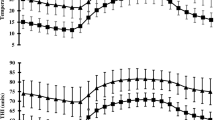Summary
Six feral does maintained at elevated ambient temperatures (27·2°–34·8°) for the last half of pregnancy had rectal temperatures (Tr) elevated by 0·4° above 10 unstressed does. Heat-stressed twin-bearers were 0·15° hotter than single-bearers and bore lighter kids (1·70 kg), than unstressed does (2·24 kg) while single were less affected (2·22 kg versus 2·28 kg). Birth weight was more highly correlated (P<0·001) with the daily minimum Tr of the dam than with the mean or maximum Tr. Kids from heated does stood and began sucking as quickly as control kids but during the first six hours scored significantly (P<0·01) lower on a scale of general activity. There were no significant differences in body content of nitrogen, fat and ash or, when birth weight was considered, weight of hide, CNS and liver.
Résumé
Six chèvres en liberté maintenues à des températures ambiantes élevées (27°2–34°8) pendant la seconde partie de leur gestation ont présenté des températures reactales (Tr) de 0°4 supérieures à celles de 10 chèvres non stressées. Les porteuses de jumeaux stressées par la température ont 0°15 de plus que les uniporteuses et ont des agneaux plus légers (1,70 kg) que les non stressées (2,24 kg); les uniporteuses sont moins affectées (2,22 kg contre 2,28 kg). Le poids à la naissance présente une plus forte corrélation (p>0,001) avec la Tr journalière minimum de la mère qu’avec la Tr moyenne ou maximum. Les chevreaux nés de mères soumises à la chaleur se relèvent et commencent à téter aussi vite que les chevreaux contrôlés mais pendant les six premières heures ont des performances significativement inférieures (p>0,01) au plan de l’activité générale. Il n’y a pas de différences significatives pour le contenu corporel en azote, en graisses et en cendres, ni, lorsque l’on prend en compte le poids à la naissance, le poids de la peau, du système nerveux central et du foie.
Resumen
Seis cabritillos salvajes mantenidos a temperature elevada (27.2°–34.8°), durante la última mitad de la preñez, tuvieron temperaturas rectales 0.4° superiores, a las de 10 cabritillos controles, mantenidos sin el estrés del calor. Los cabritillos nacidos de madres bajo el estrés del calor, mellizos, tenían 0.15° por encima de los no mellizos y fueron más livianos (1.70 kg), que los mellizos nacidos de madres no sometídas a estrés (2.24 kg); mientras los no mellizos fueron menos afectados en relación al peso (2.22 kg versus 2.28 kg). Los pesos al nacer, tuvieron una alta correlación (p<0.001) con la temperatura rectal mínima diaria de la madre, más que con la media o con la temperatura máxima. Los cabritillos nacidos de madres estresadas, se pararon y empezaron a mamar tan pronto como los controles, pero durante las primeras seis horas, fueron significativamente menos activos (p<0.001) que los controles. No se presentaron diferencias significativas, en el contenido corporal de nitrógeno, grasa y cenizas entre unos y otros, cuando se tomó en cuenta el peso al nacer, así come tambien el peso de los cueros, sistema nervioso central e hígado.
Similar content being viewed by others
References
Ahmed, I. A. * Tantawy, A. O. (1960).Empire Journal of Experimental Agriculture,28, 104–108.
Alexander, G. & Williams, D. (1971).Journal of Agricultural Science, Cambridge,76, 53–72.
Brown, D. E. & Harrison, P. C. (1981).Journal of Animal Science,52, 1114–1121.
Cartwright, G. A. & Thwaites, C. J. (1976)Journal of Agricultural Science, Cambridge,86, 573.
Church, D. C. (1972).Digestive Physiology and Nutrition of Ruminants, Vol. 3, D. C. Church, Oregon. pp. 264–268.
Holmes, J. H. G. & Absalom, P. (1986).Papua New Guinea Journal of Agriculture, Forestry and Fisheries, (in press).
Prasetyo, S., Miller, H. M., Scheurmann, E. A. & Holmes, J. H. G. (1984)Proceedings of Australian Society of Animal Production,16, 541–544.
Reynolds, L. P., Ferrell, C. L., Nienaber, J. A. & Ford, S. P. (1985).Journal of Agricultural Science, Cambridge,104, 289–297.
Richards, J. J. (1985).Tropical Animal Health and Production,17, 141–152.
Shelton, M. & Huston, J. E. (1968).Journal of Animal Science,27, 153–158.
Yeates, N.T.M. (1956).Australian Journal of Agricultural Research,7, 435–439.
Yeates, N. T. M. (1958).Journal of Agricultural Science, Cambridge,51, 85–89.
Author information
Authors and Affiliations
Rights and permissions
About this article
Cite this article
Holmes, J.H.G., Prasetyo, S., Miller, H.M. et al. Effect of chronic heat load during pregnancy on birth weight, behaviour and body composition of Australian feral goat kids. Trop Anim Health Prod 18, 185–190 (1986). https://doi.org/10.1007/BF02359533
Issue Date:
DOI: https://doi.org/10.1007/BF02359533




